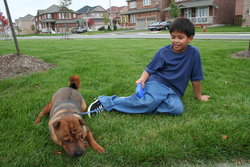Support
Service Animals

You may already be familiar with service animals that assist people who have vision loss, but service animals assist people with other disabilities as well.
The customer service standard requires you to let people with disabilities bring their service animals places that are open to the public or other third parties when accessing your services.
To be considered a service animal under the customer service standard, it must either be "readily apparent" that the animal is being used because of a person's disability or the person with a disability must be prepared to show a letter from a doctor or nurse confirming that it is required for reasons relating to his or her disability.
It's "readily apparent" that an animal is a service animal when it is obvious by its appearance or by what it is doing. For example, it may be readily apparent that an animal is a service animal if it is wearing a harness, saddle bags, a sign that identifies it as a service animal or has a certificate or identification card from a service animal training school or an identification card from the Attorney General of Ontario.
It may also be readily apparent if a person is using the animal to assist him or her in doing things, such as opening doors, alerting its owner of a sound or retrieving items.
Where an animal is not a trained guide dog and it is not readily apparent that the animal is a service animal, you may ask the person using the service animal for a letter from a doctor or nurse that says the animal is needed because of a disability. The letter need only explain that the animal is required because of a disability. The letter doesn't need to identify the disability, why the animal is needed or how it is used.
If an animal is a guide dog you may have additional obligations under the Blind Persons' Rights Act.
Which of the following do service animals assist? (Choose your answer can click to find out if you are right.)
Answer: All of the above.
Tips for interacting with a person with a service animal:
Approach and Introduction:
- A service animal is not a pet
- Introduce yourself to the person
Communication:
- Ask the person if s/he would like some assistance. A person with vision loss may want to take your arm, with her dog accompanying both of you. Or, s/he may instruct her dog to find and follow you as you walk ahead. Or s/he may simply ask for directions and proceed on her own.
- If s/he wants to instruct her dog to follow you, walk a few paces ahead and provide verbal directions as you go ("we're going to be taking the next left"). The person with will instruct her dog.
Physical contact:
- Offer your arm by making contact with the back of the person's hand. They may have a preference about which arm s/he chooses, depending on how s/he normally positions her dog.
Behaviour:
- Avoid touching, talking to or making eye contact with the service animal.
- When the dog is wearing its harness, it is on duty.
- If you must take the dog while assisting the person, hold the leash rather than the harness.
- It is best to transport the person with a disability and his/her service animal together .
Learn More
Learn more at The Lions Foundation of Canada Dog Guides




